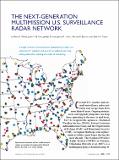The Next-Generation Multimission U.S. Surveillance Radar Network
Author(s)
Benner, William E.; Torok, Garth S.; Weber, Mark E.; Cho, John Y; Herd, Jeffrey S.; Flavin, James M; ... Show more Show less
Downloadbams-88-11-1739.pdf (5.724Mb)
PUBLISHER_POLICY
Publisher Policy
Article is made available in accordance with the publisher's policy and may be subject to US copyright law. Please refer to the publisher's site for terms of use.
Terms of use
Metadata
Show full item recordAbstract
The U.S. Government operates seven distinct radar networks, providing weather and aircraft surveillance for public weather services, air traffic control, and homeland defense. In this paper, we describe a next-generation multimission phased-array radar (MPAR) concept that could provide enhanced weather and aircraft surveillance services with potentially lower life cycle costs than multiple single-function radar networks. We describe current U.S. national weather and aircraft surveillance radar networks and show that by reducing overlapping airspace coverage, MPAR could reduce the total number of radars required by approximately one-third. A key finding is that weather surveillance requirements dictate the core parameters of a multimission radar—airspace coverage, aperture size, radiated power, and angular resolution. Aircraft surveillance capability can be added to a phased array weather radar at low incremental cost because the agile, electronically steered beam would allow the radar to achieve the much more rapid scan update rates needed for aircraft volume search missions, and additionally to support track modes for individual aircraft targets. We describe an MPAR system design that includes multiple transmit–receive channels and a highly digitized active phased array to generate independently steered beam clusters for weather, aircraft volume search, and aircraft track modes. For each of these modes, we discuss surveillance capability improvements that would be realized relative to today's radars. The Federal Aviation Administration (FAA) has initiated the development of an MPAR “preprototype” that will demonstrate critical subsystem technologies and multimission operational capabilities. Initial subsystem designs have provided a solid basis for estimating MPAR costs for comparison with existing, mechanically scanned operational surveillance radars.
Date issued
2007-11Department
Lincoln LaboratoryJournal
Bulletin of the American Meteorological Society
Publisher
American Meteorological Society
Citation
Weber, Mark E.; Cho, John Y. N.; Herd, Jeffrey S. et al. “The Next-Generation Multimission U.S. Surveillance Radar Network.” Bulletin of the American Meteorological Society 88, 11 (November 2007): 1739–1751 © American Meteorological Society
Version: Final published version
ISSN
0003-0007
1520-0477